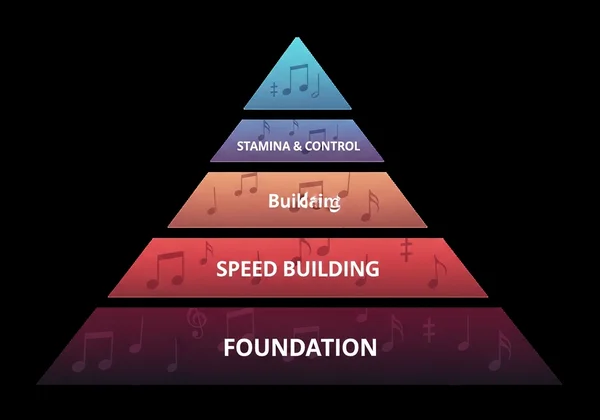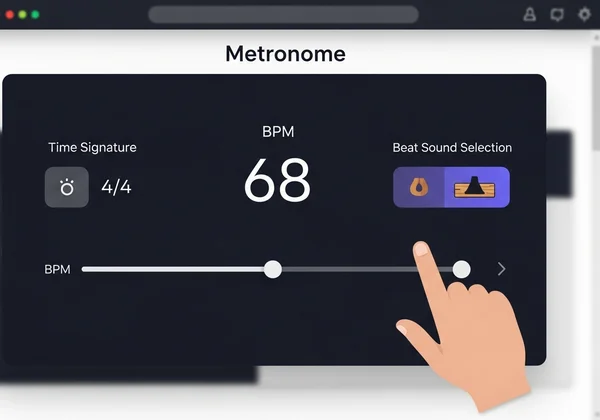Metronome Practice Routine: Build Speed & Stamina
Hitting a plateau in your musical journey is frustrating. You practice for hours, but your speed doesn't increase, your timing feels inconsistent, and complex passages remain just out of reach. This is where a structured metronome practice routine transforms your efforts from aimless repetition into targeted, measurable progress. But how can I use a metronome effectively to improve my rhythm? The secret lies in moving beyond simply turning it on; it’s about using it as a systematic training partner.
This guide will introduce you to the "Practice Pyramid," a powerful framework designed to build your rhythmic foundation from the ground up. We will break down actionable strategies that apply to any instrument, helping you develop flawless timing, incredible speed, and unwavering stamina. To get the most out of these exercises, you'll need a reliable, customizable tool. We recommend opening the free online metronome on our homepage to follow along and start building your skills today.

Understanding Your Practice Pyramid: Foundations of Rhythmic Mastery
The Practice Pyramid is a methodical approach to musical practice. Instead of randomly trying to play faster, you build your skills in logical layers. The base of the pyramid is slow, deliberate, and accurate practice. As you ascend, you systematically increase tempo and complexity, ensuring that your technique remains solid at every stage. This structure prevents the development of bad habits that often arise from rushing the process.
Why a Structured Approach Transforms Your Playing
A structured routine provides a clear roadmap for your practice sessions. It eliminates guesswork and ensures that every minute you spend with your instrument is productive. By focusing on one layer of the pyramid at a time, you can achieve true rhythmic mastery. This builds not only technical skill but also deep musical confidence. You'll know you can handle a certain tempo because you built up to it correctly, note by note.
The Core Principles of Progressive Tempo Training
At the heart of the pyramid is the concept of progressive tempo training. This method is built on three simple but powerful principles. First, start slower than you think you need to. Accuracy is the priority. Second, make small, incremental jumps in speed. This allows your brain and muscles to adapt without feeling overwhelmed. Finally, be consistent. Regular, focused practice, even in short bursts, yields far better results than occasional marathon sessions.
Laying the Foundation: Accurate Rhythm for Every Instrument
Before you can build speed, you must establish a rock-solid rhythmic foundation. This first stage of the pyramid is non-negotiable and requires absolute precision. It's about teaching your body what a perfectly steady beat feels like, creating a strong internal clock that will serve you throughout your musical career. This foundational work is where a great online tool makes all the difference.
Setting Up Your Metronome: BPM, Time Signatures & Beat Sounds
Your metronome is your most honest practice partner. To begin, navigate to our online metronome tool and get comfortable with its features. Start by setting a slow tempo—perhaps 60 BPM (beats per minute). Choose a clear, audible beat sound that cuts through the sound of your instrument, like a woodblock or cowbell. Ensure you've selected the correct time signature for the piece you're practicing. Customizing these settings correctly is the first step toward a productive session.

The Slow Practice Imperative: Consistency Over Speed
The golden rule of the foundation stage is prioritizing consistency over speed. At a slow tempo, your goal is to play every single note perfectly in time with the click. Listen intently. Is the attack of your note happening precisely with the beat, or slightly before or after? This meticulous work builds clean technique and muscle memory. It might feel tedious, but mastering your instrument at slow speeds is the fastest way to play it well at high speeds.
Strategies to Build Guitar & Piano Speed Systematically
Once your rhythmic foundation is stable, you can begin the ascent up the pyramid. This next stage focuses on systematically increasing your playing velocity without sacrificing the accuracy you've worked so hard to achieve. These strategies are particularly effective for instruments like guitar and piano, where speed and dexterity are often primary goals. Remember to use a reliable tool to set your tempo for these exercises.
The Incremental Tempo Increase Method (e.g., The "5 BPM Rule")
The "5 BPM Rule" is a cornerstone of an effective incremental tempo increase. Start at a tempo where you can play a passage perfectly three times in a row. Then, increase the metronome speed by just 3-5 BPM. Play the passage again until you can execute it perfectly three consecutive times at the new speed. This gradual process ensures your technique remains clean as the tempo rises, preventing the onset of tension and sloppy playing.
Mastering Difficult Sections: Loop Practice & Subdivision Focus
Every piece of music has that one difficult section that trips you up. Isolate it. Using the metronome, loop this short passage at a slow speed. Pay close attention to the rhythm, especially the subdivisions of the beat—the eighth or sixteenth notes between the clicks. Our BPM tool is perfect for this. By focusing on loop practice & subdivision, you are essentially putting that difficult passage under a microscope and polishing every note until it's perfect.

Beyond Speed: Techniques to Increase Playing Speed & Stamina
Reaching the peak of the pyramid involves more than just raw speed; it requires developing musical stamina and control. These advanced techniques are designed to push your boundaries, refine your internal rhythm, and add a layer of musicality to your newfound velocity. This is where you transform technical ability into expressive performance.
Incorporating Burst Training & Dynamic Accents
Speed burst training & dynamic accents involves setting your metronome to a moderate tempo and playing a passage at double that speed for one or two measures, then returning to the original tempo. This trains your fingers to move quickly on command. Additionally, practice accenting different beats (e.g., the "and" of each beat) to improve your rhythmic control and make your playing more dynamic and engaging. This exercise dramatically improves your ability to handle fast passages with confidence.
The Power of Silent Metronome Practice for Internal Rhythm
This is an advanced exercise that truly tests your internal rhythm. Set your metronome to play for one measure and then be silent for the next. Your task is to continue playing in perfect time during the silent measure, aiming to land precisely on the downbeat when the click returns. You can test your rhythm with this challenging technique. It’s one of the most effective ways to transition from relying on an external beat to possessing an unwavering internal clock.

Tailoring Your Metronome Practice Routine for Success
The Practice Pyramid is not a rigid-one-size-fits-all-plan. It's a flexible framework. The most effective metronome practice routine is one that you adapt to your specific instrument, goals, and musical style. Customizing this approach will keep you engaged and ensure your practice remains relevant to the music you want to play.
Adjusting the Pyramid for Different Instruments & Musical Styles
A drummer might use the pyramid to work on complex polyrhythms, while a vocalist might use it to practice precise pitch control on long notes. For different instruments, the application changes, but the principle of systematic, incremental progress remains the same. A jazz musician might use the metronome to practice swinging eighth notes, while a classical player focuses on the evenness of their scales. Tailor these exercises to fit your needs.
Tracking Your Progress: Witnessing Your Rhythmic Growth
Keep a practice journal. For each exercise, log your starting BPM and your target BPM. Make notes on how a passage felt and what challenges you faced. Tracking your progress provides powerful motivation. Looking back after a few weeks and seeing that a tempo you once struggled with now feels easy is incredibly rewarding. It provides tangible proof that your structured work is paying off.
Your Journey to Rhythmic Excellence Starts Now
Mastering an instrument is a journey of a thousand small steps, and a metronome is your guide for every one of them. By adopting the Practice Pyramid framework—building a solid foundation, systematically increasing speed, and incorporating advanced techniques—you transform your practice from a chore into a clear path toward excellence. Your timing will become impeccable, your speed will increase without sacrificing clarity, and your musical confidence will soar.
The key is to start today. Don't wait for inspiration to strike. Open our powerful and completely free online metronome, set it to a slow tempo, and take the first step. Your future self will thank you for the disciplined, focused work you do right now.
Frequently Asked Questions About Metronome Practice
What is a good BPM for practice, especially when starting out?
A good BPM for practice is one where you can play a piece or exercise perfectly, without any mistakes or physical tension. For many beginners, this could be as slow as 50-70 BPM. The exact number doesn't matter; the goal is 100% accuracy. Start slow, build a solid foundation, and the speed will follow naturally.
How can I use a metronome effectively to improve my rhythm?
To use a metronome effectively, integrate it into every aspect of your practice. Use it for scales, chords, and full pieces. Focus on aligning the attack of your notes precisely with the click. Challenge yourself with advanced exercises like silent metronome practice or accenting off-beats to develop a truly independent and reliable internal sense of time.
Can using a metronome truly improve my overall musicality and internal rhythm?
Absolutely. While it may seem mechanical, a metronome is a tool for liberation. By internalizing a steady pulse, you free up your mental capacity to focus on the expressive elements of music—dynamics, articulation, and phrasing. A solid internal rhythm is the canvas upon which all musicality is painted. You can start building yours today with our customizable metronome.